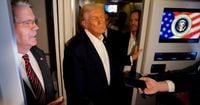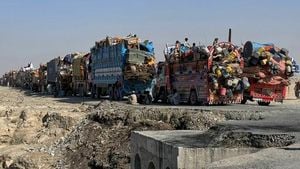In a dramatic turn of events in Latin America, the United States has thrown its considerable economic weight behind Argentina’s embattled libertarian president, Javier Milei, providing a staggering $82 billion in new debt to prop up his administration and counter the growing influence of China in the region. This move, orchestrated by the Trump administration, has sent shockwaves through both Argentine society and the international community, raising questions about sovereignty, democracy, and the future balance of power in the Western Hemisphere.
According to Geopolitical Economy, the $82 billion lifeline consists of $40 billion directly from the Trump administration—split evenly between a $20 billion swap line with the US Treasury and $20 billion in private-sector loans facilitated by Washington—and an additional $42 billion from international financial institutions largely controlled by the United States. These include $20 billion from the International Monetary Fund (IMF), $12 billion from the World Bank, and $10 billion from the Inter-American Development Bank (IDB).
Argentina’s reliance on foreign credit is nothing new. The country already owed $43 billion to the IMF before Milei took office, making it the institution’s largest debtor by a wide margin. Now, with the new debt package, Argentina’s IMF obligations are projected to soar to an astonishing 1,352% of its quota by 2026, according to internal IMF documents cited by Geopolitical Economy. That’s a figure so large it almost defies belief—and it underscores the depth of Argentina’s financial crisis.
This influx of debt is not just a matter of numbers. The new dollar-denominated loans are nearly equal to the value of all of Argentina’s exports in a single year, representing 12% of the nation’s GDP at market exchange rates (or 5.5% at purchasing power parity). Critics, both within Argentina and abroad, warn that the country is being ensnared in a devastating debt trap—one that could leave it effectively under the fiscal control of Washington and its allies for years to come.
“People in Argentina now say openly that Milei is turning their country into a ‘colony of the US’,” Geopolitical Economy reports. The comparison is not lost on observers, who recall the US-imposed Financial Oversight and Management Board—known as La Junta—that governs Puerto Rico without meaningful input from its people. The implication is clear: with the IMF calling the shots, Argentina’s democracy may be little more than a façade.
Behind the scenes, the architects of Argentina’s economic policy have deep ties to Wall Street. As Geopolitical Economy notes, Milei’s minister and vice minister of economy, as well as the president and vice president of the central bank, all previously worked for JPMorgan, the largest US bank. This has fueled accusations that Argentina’s “anarcho-capitalist” experiment is, in reality, a project of Wall Street and Washington, not Buenos Aires.
The US intervention has not gone unnoticed in the context of the ongoing US-China trade war. As reported by MyIndMakers and Business Today, Trump’s aggressive tariff policies have roiled global markets, prompting China to retaliate by halting imports of US soybeans and turning to South American suppliers instead. In 2024 and 2025, Chinese imports of Argentine soybeans surged by an eye-popping 91.5%, while imports from Brazil also spiked. This strategic shift left American farmers stunned and underscored China’s growing economic leverage.
China’s influence in Argentina extends far beyond agriculture. In recent years, Beijing has signed sweeping infrastructure, energy, and mining agreements with Argentine provinces, often bypassing the national government. Chinese companies now dominate Argentina’s telecommunications network (with Huawei at the helm), and China is the top destination for Argentine beef, accounting for over half the country’s exports. China has also constructed hydroelectric plants, solar parks, and a nuclear power plant, and even operates an aerospace base in Neuquen.
Perhaps most significantly, China and Argentina have maintained a currency swap agreement since 2009, which was renewed for $5 billion in April 2025. This arrangement allows Argentina to convert yuan into dollars to repay debts, providing a crucial lifeline as the country’s foreign reserves dwindle. The US, wary of China’s deepening role, pressured Argentina to end the swap, but Beijing shot back, insisting that the agreement “contributes to Argentina’s economic and financial stability and is welcomed by the Argentine government,” according to Business Today.
Javier Milei’s path to power has been anything but smooth. After winning the 2023 presidential election on a platform of radical market reforms and hostility to “communist” regimes, Milei initially rejected joining the BRICS group and promised to shun business with China. But economic realities soon intervened. Facing runaway inflation—peaking at 300%—and a collapsing peso, Milei implemented harsh austerity measures, which succeeded in reducing inflation to 100% by December 2024. Yet the medicine proved bitter, sparking widespread protests and, in February 2025, a financial scandal involving $99 million withdrawn from a government-promoted crypto token.
With the economy teetering, Milei turned to the IMF for a $20 billion bailout—Argentina’s 22nd since 1958. But the peso’s continued collapse ahead of the October 2025 legislative elections threatened to topple his government. That’s when Trump stepped in, first with a $20 billion aid package, then promising to double it if Milei secured victory in the midterms. According to MyIndMakers, Trump warned, “If he loses, we are not going to be generous with Argentina.” After Milei’s triumph, the full $40 billion US package was approved, including a $20 billion currency swap and $20 billion from private banks and sovereign wealth funds.
The move sparked outrage in Washington, with American farmers—already reeling from China’s pivot to South American soybeans—calling the bailout “awkwardly contradictory to the ‘America First Agenda.’” Democrats attempted to pass a “No Argentina Bailout Act,” while even some Trump supporters balked at helping a competitor. Nevertheless, the administration pressed on, framing the intervention as part of an “economic Monroe Doctrine” to reassert US dominance in the hemisphere and counter China’s advance.
“This package is part of the economic Monroe Doctrine of asserting the United States’ domination in the Western Hemisphere,” stated Bessent, as reported by MyIndMakers, while presenting the Atlantic Council’s Global Citizen Award to President Milei. The message was unmistakable: Washington would not cede its backyard to Beijing without a fight.
For Argentina, the future remains deeply uncertain. The country’s new debt burden is, by most accounts, unpayable. As Geopolitical Economy bluntly put it, “It is impossible for Argentina to earn enough foreign currency to pay off this dollar-denominated debt. It is unpayable. Period.” Yet, with both the US and China vying for influence, Argentina finds itself at the center of a high-stakes geopolitical chess match—its sovereignty, economy, and democracy hanging in the balance.
As the dust settles after the October 2025 legislative elections, one thing is clear: the fate of Argentina will be shaped not just in Buenos Aires, but in the corridors of power in Washington and Beijing. And for ordinary Argentines, the struggle for true independence and prosperity continues, caught between rival superpowers with their own competing visions for the future of the Americas.






